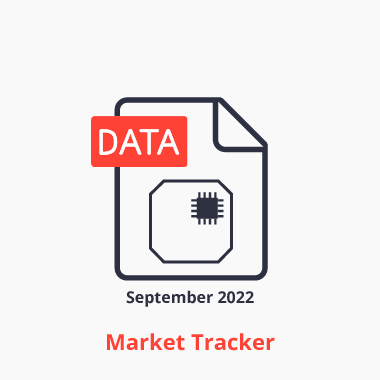Key insights
- The global cellular IoT module market has grown from two to 10 key technologies. At the same time, the market has grown 15 times since 2010 according to IoT Analytics’ latest research on the topic.
- Module companies have expanded their portfolio from hardware-only to bundling hardware, software, connectivity solutions, and services to provide end-to-end solutions.
- Recently, IoT module prices have significantly increased due to the global chip shortage.
Evolution of cellular IoT modules from 2010-2022
Between 2010 and 2022, the cellular IoT module market grew 15 times, with approximately 2.5 billion modules forecasted to be shipped by the end of 2022. The market for IoT modules exploded at an unprecedented rate during this time, and the market dynamics have changed. For example, in 2010, the top five module companies contributed 82% of global cellular IoT module shipments, whereas in 1H 2022, that number reduced to 55%. To understand this change and evolution, we highlight 10 insights on how the technology landscape and the competitive landscape have changed since 2010.
Five key insights on the shifts in the cellular connectivity technology landscape
1. From two to 10 technologies
In 2010, the cellular IoT module market consisted of only two connectivity technologies, 2G and 3G, with 57% and 43% shipment shares, respectively. In 1H 2022, those technologies made up 5% and 1% market share, respectively. At the same time, eight major new technologies have been introduced to the market.
2. The rise of LTE-CAT 1
2014 marked the beginning of the rise of the LTE-Cat 1 technologystandard. It is defined by 3GPP’s Release 8, which specifies that each IoT module comes embedded with two receiver (Rx) antennas based on either Intel or Qualcomm chipsets. LTE CAT 1 first started to become the go-to alternative for 2G and 3G IoT applications in North America when 2G networks were being retired by network operators at the end of 2017. The massive migration from 2G/3G to LTE-Cat 1 started in 2018.
3. Adoption of NB-IoT
In 2018, we started to see the first adoption of NB-IoT based on HiSilicon chipsets. NB-IoT became the new alternative for 2G IoT applications in China. At that time, most US operators relied on LTE-M. However, soon after, many started to opt for a dual model (NB-IoT+ LTE-M) LPWA strategy. Hence, since 2019, we have seen mass adoption of the LPWA dual mode module, with adoption still growing at a higher rate than LTE-M in 1H 2022.
4. The new LTE-Cat 1 bis
The absence of LTE-M in China and the technical limitations within NB-IoT in 2020 led to a rise in demand for a new segment: low-cost LTE-Cat 1 bis modules. Cat 1 bis, based on 3GPP Release 13, is characterized by a single antenna and is optimized for low-power applications. Further, LTE-Cat 1 bis is emerging as a viable alternative to LPWA technology, especially in Europe and Latin America. As predicted by IoT Analytics in last year’s IoT Module analysis, both LTE Cat 1 and LTE-Cat 1 bis shipments grew in 1H 2022 by 37% and 41% YoY, respectively.
5. The slow takeoff of 5G
The latest addition to the IoT connectivity stack was 5G, and it was expected to take off in 2021. However, due to inhibiting factors, such as the COVID-19 pandemic, the chip shortage, and increased prices and inflation, 5G today only stands at a 2% market share of global cellular IoT module shipments (1H 2022). We expect that after the 3GPP release 17, we will see a higher 5G adoption rate. We also expect that the first 5G red cap modules to be released in 2024.
Five key Insights on the shift in the IoT module competitive landscape
1. Early market leadership by Sierra Wireless and Gemalto
In 2010, Gemalto acquired Cinterion and became the 2nd largest global cellular IoT module provider behind Sierra Wireless. At that time, SIMCom was the only Chinese module player in the global cellular IoT module shipments ranking.
2. The rise of Quectel
In 2016, Chinese module maker Quectel entered the global top five rankings, replacing uBlox for the first time. Low pricing was Quectel’s key strategy for penetrating the market. In the same year, Telit acquired Novatel Wireless, strengthening its Security and Surveillance segment.
3. Quectel’s market leadership
In 2018, Quectel, for the first time, ranked #1 in China’s cellular IoT module shipments ranking, replacing Sunsea AIoT. In 2019, one year later, the company also, for the first time, ranked #1 globally, replacing Sierra Wireless in the top spot. Quectel is still leading the global ranking in 1H2022, and we expect the company’s market leadership to continue over the next four years.
4. The rise of other Chinese players
In 2017, Sunsea AIoT acquired both Long Sung Tech and SIMCom and remained ranked #2 for three consecutive years (2018–2020). In 2020, Fibocom entered the top 5 ranking for IoT module shipments outside of China for the first time. In 2021, China Mobile OneMo entered the top 5 ranking for the first time in China’s cellular IoT module shipments ranking due to the high-volume shipment of NB-IoT modules.
5. Divestments and acquisitions
While Chinese companies gained market share, Western companies refocused their activities and ownership structures. In 2019, Telit sold its automotive business segment to TUS International, while French aerospace supplier Thales acquired Gemalto. In 2020, Sierra Wireless sold its automotive business segment to Rolling Wireless. In July 2022, Telit and Thales jointly announced the formation of Telit Cinterion, with Thales holding a 25% stake in Telit Cinterion. Telit Cinterion plans to spin off the automotive IoT unit again after completing the merger. In August 2022, semiconductor company Semtech announced its intent to acquire Sierra Wireless. The announcement raised many eyebrows in the industry as Semtech had advocated for unlicensed low-power wide-area standard LoRA for a long time. It appears Semtech’s vision is to go beyond selling hardware. Semtech is looking to scale Sierra Wireless’ high-margin IoT Cloud services, which are part of Sierra Wireless’s end-to-end IoT product, connectivity, and services portfolio. Semtech will likely also allow its customer to opt for both licensed (NB-IoT and LTE-M) and unlicensed LPWA (LoRa) connectivity depending on the use cases and application requirements.
IoT Module market in 2022
In the last 12 years, the IoT Module market has undergone significant changes; the market has grown with significant market leadership changes. Module companies have also expanded their portfolio from hardware-only to bundling hardware, software, connectivity solutions, and services to provide end-to-end solutions (e.g., Telit’s deviceWise and OneEdge or U-Blox’s addition of Thingstream).
This month, IoT Analytics updated its research on the topic by publishing the Global Cellular IoT Module and Chipset Market Tracker & Forecast, which provides a quarterly look at the revenues and shipments of 36 cellular IoT module companies and 14 IoT chipset companies.
The data shows that in 1H 2022, global cellular IoT module shipments and revenue grew 22% and 38% YoY, respectively. At the same time, global cellular IoT chipset revenue grew by 42% year-on-year. The growth outperformance of chips vs. modules was due to higher adoption of more expensive integrated chipsets.
IoT module prices have also increased significantly on the back of the global chip shortage. The average cellular IoT chipset wholesale selling price grew 16 % in 1H 2022 (compared with 1H 2021). The average cellular IoT module chipset wholesale selling prices increased 13% in the same period. Although the chip shortage situation in 1H 2022 has improved compared with 1H 2021, chipset lead times are still far from pre-crisis levels.
Comments on recent M&A activity
Telit acquiring Thales’ IoT portfolio
“Telit Cinterion is expected to put further pressure on the other Western module suppliers due to its broadened portfolio including security and eSIM/iSIM capabilities. The company is also spinning off its automotive IoT unit to focus on Industrial IoT. We expect Telit Cinterion to become the second biggest IoT module company outside China when the acquisition closes.”
Satyajit Sinha, Principal Analyst at IoT Analytics
Semtech acquiring Sierra Wireless
“In the digital supply chain age, end-to-end tracking demands multiple connectivity modes. Hence, the collaboration of cellular and LoRa technology is expected to be beneficial for end-to-end tracking. Cellular components had been missing from the Semtech portfolio prior to the acquisition. For example, if chipsets such as the Lora Edge LR1120 get embedded into a combined module with LTE-M or Cat 1, the resulting module covers almost all major wireless types of connectivity, including Sub-GHz LoRa, SATCOM S-band, 2.4 GHz Lora, and Cellular IoT.”
Satyajit Sinha, Principal Analyst at IoT Analytics
Outlook: The cellular IoT module market until 2026
With 6 billion cellular IoT connections expected by 2026, the market for cellular IoT continues to be in a long-term cyclical uptrend with smart meter, Transportation, Supply Chain and Logistics, and Automotive and Telematics industries at the forefront of module consumption.
Shipments of 5G are expected to contribute toward 16% of shipment share by 2026. Furthermore, the rise of 5G and later 5G redcap is expected to play a key part in the market’s growth beyond 2026. There is also a trend towards the adoption of module-based design (vs. chipset-based design), especially in the industrial and enterprise spaces.
From a competitive perspective, we expect to continue to see fierce competition between Western and Chinese module companies. Prices continue to play a key role in gaining volume in the market. However, we do not think that IoT modules will end up as a pure commodity. Differences in implementation security, eSIM /iSIM, and end-to-end solutions (among others) remain some of the key features affecting the decision-making when opting for a specific module company.
More information and further reading
For more insights, check out our coverage of the IoT hardware and connectivity market:

Global Cellular IoT Module and Chipset Market Tracker & Forecast (Q3/2022 Update)
A nested market database that represents the updated view of the cellular IoT module and chipset market for the 2018–2022 period, including a forecast for the 2022–2026 period.
- In-depth look at the quarterly market for cellular IoT modules and chipsets.
- Includes over 1.7 million data points, that allow for detailed drill-down options per region, technology, industry, and company.
- The tracker gets updated with the most recent data every 6 months.
Related market data
You may be interested in the following IoT market data products:
- Global Cellular IoT Module and Chipset Tracker and Forecast
- Global Cellular IoT Connectivity and LPWA Tracker and Forecast
Related publications
You may be interested in the following publications:
- IoT Communication Protocols Adoption Report 2022
- Satellite IoT Market Report 2022-2026
- LPWAN Market Report 2021–2026
- 5G Market Report 2019-2025
Related articles
You may also be interested in the following recent articles:
- 5 things to know about IoT protocols
- Satellite IoT connectivity: Three key developments to drive the market size beyond $1 billion
- 5 things to know about the LPWAN market in 2021
- The Leading 5G IoT Use Cases
Are you interested in continued IoT coverage and updates?
Subscribe to our newsletter and follow us on LinkedIn and Twitter to stay up-to-date on the latest trends shaping the IoT markets. For complete enterprise IoT coverage with access to all of IoT Analytics’ paid content & reports including dedicated analyst time check out the Enterprise subscription.

